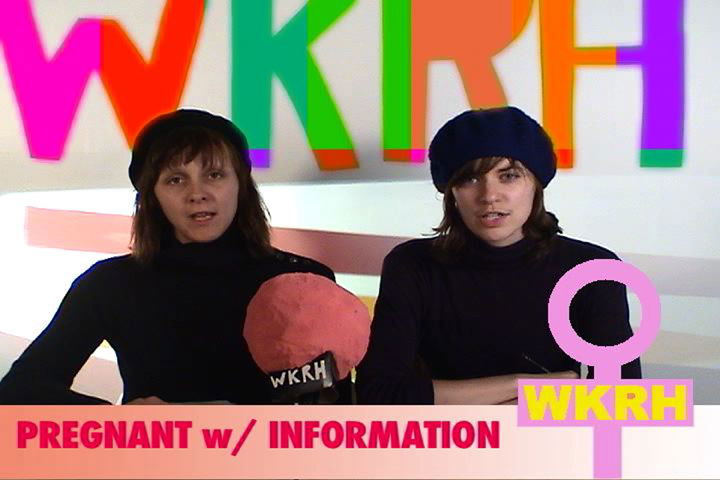
In the video New Report, Wynne Greenwood and K8 Hardy are reporters at WKRH - the feminist news station that is pregnant with information. As Henry Irigaray (Hardy) and Henry Stein-Acker-Hill (Greenwood), these two lesbian feminist artists stage reports on and with their friends, their social herstories, their nerves, and their bodies. It is urgently broadcast live to the newsroom and out to their studio audience. An ongoing collaboration, New Report investigates how news is made and received, while restating the spaces, crises, and histories that deserve to be publicly considered.
Pregnant w/information' is WKRH's promotional logo, and the advertising is not false.
b. 1977
Wynne Greenwood (b. 1977 in Seattle, where she still lives and works) is a queer feminist artist who works with video, performance, music and object-making to practice culture-healing. Her work has been included in performances and exhibitions at independent and institutional spaces internationally, including the Tate Modern, Whitney Biennial, The Kitchen and On the Boards. From 1999 - 2006, Greenwood performed the multimedia art-band Tracy + the Plastics. Upon ending the project, Greenwood shifted her focus to installation and object-based work, exhibiting with Susanne Vielmetter Los Angeles Projects and Lawrimore Project in Seattle. Most recently, Greenwood participated in Anti- Establishment, a group show at Bard College's Center for Curatorial Studies, and released the full-length music album A Fire To Keep You Warm. Greenwood also teaches performance and video through workshops and after-school programs.
b. 1977
K8 Hardy’s (b. 1977 in Forth Worth, Texas, lives and works in Brooklyn) palette draws on the tropes of fashion advertising, combining some of its most recognizable modes—product close-ups, meticulous styling and staging, eye-catching colors —into an abstraction of the genre. Juxtaposing a variety of aesthetics from different spheres of fashion, her photographs and sculptures employ layering to confuse and undermine assumptions about race, class, economics, and gender; the photographs often incorporate multiple images superimposed onto one another or photograms added during the development process. Rather than simply poking fun at fashion and its commercialization, Hardy complicates our learned response to the conventions of advertising. She obscures any glimpse of the model (typically the artist herself), while drawing attention instead to the messages projected by a model’s physical features. In treating her own body as an object, Hardy upends a relatively recent yet deep history of women photographing themselves, itself a response to the millennia-old practice of male artists objectifying women as subjects of art.